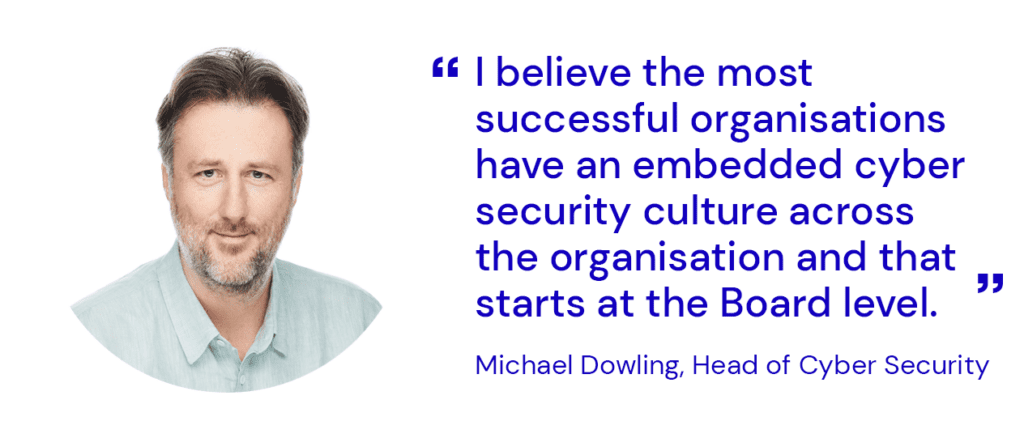Cyber Security maturity: 4 key focus areas in 2022

Adoption, migration, optimisation, security and management services designed to deliver business agility.
Improve your security posture with tailored strategies and front-line defence services.
Scalable colocation and connectivity within a hyper secure environment.
Disaster recovery and serviced offices in secure, premium office facilities.
Tailored end-to-end solutions for your hardware ecosystem across the widest range of vendors.
Seamless management of your IT environment, underpinned by world-class cyber security, no matter where you are on your journey.
Securely and effectively operate, monitor and maintain your network.
Enjoy the comfort of a modern working space supported by world class technology, security and resilience.
Help your clients take control of their IT environment with Australia and New Zealand’s leading hardware maintenance provider.
Interactive Anywhere provides robust infrastructure solutions designed to support the seamless operation of digital environments. These solutions include scalable cloud services, reliable data storage, and efficient server management, ensuring optimal performance and uptime.
The network solutions from Interactive Anywhere encompass comprehensive design, implementation, and maintenance of secure and efficient networks. By optimising connectivity and bandwidth, these solutions facilitate seamless communication and data transfer, enhancing overall productivity and operational efficiency.
Interactive Anywhere offers dedicated end user support services that ensure users receive prompt assistance with technical issues. This includes help desk support, troubleshooting, and training, aimed at improving user experience and minimising downtime for businesses.
With a focus on safeguarding digital assets, Interactive Anywhere's cyber security solutions provide advanced protection against cyber threats. These solutions include threat detection, risk management, and compliance services, ensuring businesses can operate securely and with confidence.
Interactive offers financial institutions with secure operations, robust cyber security, seamless connectivity, end-user support, and cloud solutions, ensuring long-term resilience.
For manufacturing, precision and efficiency are paramount. Our solutions optimise operations, streamline processes, and ensure seamless connectivity to drive productivity and innovation.
In professional services, reliability and agility are crucial. Our solutions enhance efficiency, streamline workflows, and provide seamless connectivity, empowering firms to deliver exceptional client experiences and stay ahead in a dynamic market.
In aged care, precision and patient well-being are fundamental. Our solutions enhance operational efficiency, streamline workflows, and guarantee secure, seamless connectivity, empowering providers to deliver exceptional care and lead in an ever-evolving sector.
News & insights from our experts to help you drive performance and grow your business
Case studies of some of our successful collaborations with our customers and partners.
News & insights from our experts to help you drive performance and grow your business
Explore our in-depth whitepapers—strategic insights and practical solutions for smarter decision-making.
Explore expert-led insights on cloud, cybersecurity, and IT trends—actionable guidance from industry leaders.
Enterprise definitions of IT terms used across Interactive services.
We're Australia's leading IT service provider and we keep technology human.
We're Australia's leading IT service provider and we keep technology human.

The cyber threat landscape is moving at such a fast pace. We have never seen any other external factor changing and evolving so rapidly for businesses.
In fact, the Australian Cyber Security Centre (ACSC) recorded a 13 per cent increase in cybercrime reports in FY21 compared to the previous financial year, with self-reported losses totalling more than $33 billion.
To help combat this acceleration, cyber security maturity will be key for all organisations in 2022. With that in mind, here are four key areas to which businesses should turn their attention.

How we communicate threats to the Board of Directors is now an essential part of the cyber puzzle and they need to be across what’s happening in your company.
If you’re a CIO, CISO, or Head of Cyber, you need to communicate in a language the Board is going to understand. Everyone needs to be clear and aligned on what your cyber threats are, and your current capabilities to prevent, detect and respond to these threats.
Importantly, if you’re a Board member, you need to understand what your senior leaders are talking about.
As a senior leader, your reporting should translate what’s happening in the cyberspace and tie it back to how it impacts the business. You need to think, ‘what is the actual risk to the business?’ Sure, you can report that you’ve detected and patched 50 critical vulnerabilities and blocked 100 emails with malware in the last month. That’s a good measure of activity, but what threats and risks to the business have you mitigated?
Try telling a story about the potential impact that any of these vulnerabilities or malware could have caused the business if they weren’t detected or blocked. Talk about how each time you’ve blocked a malicious email or patched a vulnerable device, you’ve reduced the likelihood of a risk event happening or at least kept the risk within an acceptable tolerance level.
There’s been a significant increase in supply chain focused attacks which can obviously create problems for your company, but it can also create potential downstream implications for your customers, or make you more vulnerable to attacks on your suppliers and business partners. For example, if one of your suppliers or partners suffers a ransomware attack that takes their services offline, consider how this is going to impact your business. Do you have a Business Continuity Plan in place that takes these impacts into consideration?
These types of attacks affect every industry or ecosystem so it’s essential that your view on supply chain matures. Most organisations now do a security risk assessment on all their suppliers and have expectations on them to maintain a minimum baseline level of security maturity. So, for many organisations establishing and being able to demonstrate that baseline level of security maturity is becoming table stakes for doing business in most sectors.
Most organisations rely on cyber insurance to get them out of trouble if a cyber incident occurs. However, the claims may not always cover the financial damage associated with reputational cost and loss of business.
So, organisations need to balance their investments, between transferring risk to a cyber insurer and building up their security controls.
With that said, maturity is not just about tools. It’s also about processes and culture. You could have the best tools in the world and all it takes is for someone to click a link they’re not supposed to, which could result in a security incident. I believe the most successful organisations have an embedded cyber security culture across the organisation and that starts at the Board level.
In FY21, approximately one quarter of cyber security incidents reported to the ACSC affected entities associated with Australia’s critical infrastructure. The new amendments to the Federal Government Critical infrastructure Act is broadening the scope of industries that are considered critical infrastructure. It will include sectors such as data storage and processing, food and grocery, transport, higher education and more. These changes will place increased obligations on these industry sectors to maintain a baseline level of security maturity, which include reporting into the Australian Signals Directorate (ASD) when a cyber-attack occurs, and even needing to allow the government to step in during cyber-attacks.
So, your ability to demonstrate a level of cyber security maturity will become increasingly important. The NIST framework is a common one to measure against. Pick a framework that suits your industry and do a self-assessment to measure what level of maturity you’re at against each of the relevant criteria. Your assessment will help you understand what stage of maturity your organisation is at, what your target level of maturity needs to be, and what needs to be done to bridge the gap and demonstrate that compliance.
You can certainly do that assessment internally, but you need to understand what the right landing point is, and how to get there. Where do I start? What order do I do things in? What type of solutions are out there? That’s where you can save a lot of time and effort by working with someone that’s done this before and can help with a pragmatic and incremental roadmap to get you to where you need to be.
It’s time for a ReThink about your cyber security.
We use cookies to enhance your experience, analyse site traffic, and personalise content and ads. By clicking 'Accept,' you agree to our use of cookies. For more details, please view our Privacy Policy.